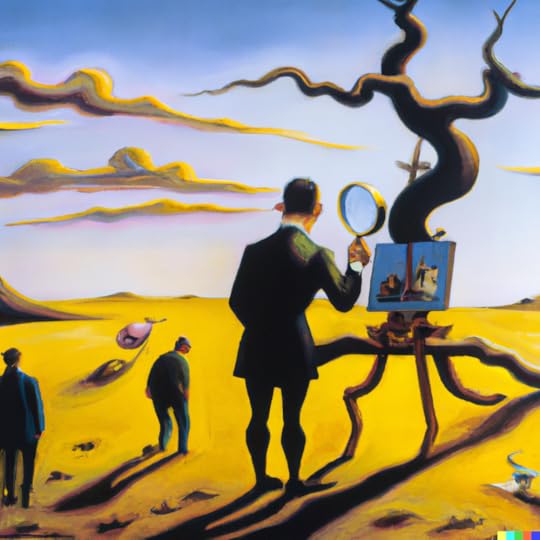Matthew Murrie's Blog, page 6
December 29, 2022
The Competitive Advantage of Curiosity: How to Foster a Culture of Learning and Growth

As the business world becomes increasingly competitive, companies are constantly searching for ways to gain an edge over their competitors. One often overlooked strategy is fostering a culture of curiosity and continuous learning within the organization.
Studies have shown that curious individuals are more likely to be innovative and successful in their careers. According to one study, ,curious individuals tend to be more open to new experiences and more likely to engage in exploration and learning.
Another ,study found that curious individuals are more likely to be engaged in their work and committed to their organization. A culture of curiosity can therefore give a company a competitive advantage by encouraging its employees to ask questions, seek out new knowledge, and come up with creative solutions to problems.
So, how can companies foster a culture of curiosity and continuous learning? Here are a few suggestions:
Encourage employees to ask questions and seek out new knowledge. This can be as simple as encouraging employees to ask their managers or colleagues for help or guidance when they are unsure about something. Companies can also provide resources such as training programs or access to online learning platforms to help employees expand their knowledge and skills. One study f,ound that employees who are given opportunities to learn and grow are more likely to be engaged and motivated in their work. Create a culture of experimentation and innovation. Encourage employees to take risks and try out new ideas, even if they might fail. This can help create a culture of continuous learning and improvement, as employees are more likely to learn from their mistakes and come up with better solutions the next time around. Other studies found that organizations with a culture that encourages experimentation and innovation are more likely to be successful . Encourage collaboration and cross-functional learning. Encourage employees to work with colleagues from different departments and backgrounds. This can help expose them to new perspectives and ways of thinking, and can also foster a sense of community and teamwork within the organization. A study published in the ,Journal of Management found that collaboration and knowledge sharing within organizations can lead to increased innovation and improved decision-making. Provide opportunities for professional development. Offer training programs and development opportunities to help employees improve their skills and knowledge. This can not only improve the performance of individual employees, but it can also benefit the company as a whole by improving the overall capabilities of the organization. Several studies have found that professional development programs can lead to increased job satisfaction and retention among employees .By fostering a culture of curiosity and continuous learning, companies can give themselves a competitive advantage by encouraging their employees to be innovative, engaged, and committed to the company's success. This not only benefits the organization, but it also helps employees grow and develop in their careers, leading to a more fulfilling and rewarding work experience.
Curious to discover how to get more from your curiosity? Please ,reach out! I would be happy to discuss the ways in which embracing and nurturing curiosity through Curiosity-Based Thinking can drive innovation and success in your organization.
,Contact me to set up a consultation and start maximizing the power of your curiosity.
December 28, 2022
Curiosity, ChatGPT, and Dinosaurs

Imagine a world where dinosaurs never went extinct. It's hard to even fathom, but it's a possibility that we must consider. Dinosaurs ruled the Earth for millions of years before they eventually went extinct, and they were the dominant group of large animals on the planet. They lived in all sorts of different environments, from the cold polar regions to the hot desert.
But what if they hadn't gone extinct? The world would be a very different place. For starters, dinosaurs would still be the dominant group of large animals on Earth. This means that other animals would have to adapt to them, rather than the other way around. Today, mammals like humans, elephants, and bears are some of the biggest and most powerful animals on the planet. But if dinosaurs were still around, they would have held onto that title.

Furthermore, the evolution of mammals and the development of human civilization as we know it may not have occurred if dinosaurs hadn't gone extinct. After the dinosaurs went extinct, the mammals that were left had a chance to evolve and become more complex, which eventually led to the development of human beings. But if dinosaurs were still around, they might have kept the mammals from evolving and becoming as advanced as they are today.
In short, if dinosaurs hadn't gone extinct, the world would be a very different place and we might not be here today. It's hard to say exactly what the world would look like, but one thing is for certain: it would be a world that we can't even begin to imagine.
If you are interested in learning more about how curiosity can be good for business in 2023 and beyond, please don’t hesitate to reach out. I would be happy to discuss the ways in which embracing and nurturing curiosity can drive innovation and success in your organization. Contact me to set up a consultation and start maximizing the power of curiosity in your business.
The Power of Human Curiosity on ChatGPT and Beyond

We are constantly seeking ways to stay ahead of the curve and stay competitive in an ever-changing market. One way to do this is to embrace and harness the power of artificial intelligence (AI), specifically, advanced language models such as ChatGPT.
ChatGPT, developed by OpenAI, is a state-of-the-art language model that is able to generate human-like text based on a given prompt and continue a conversation in a coherent and engaging manner. This capability is made possible through the use of advanced machine learning algorithms and a massive dataset of human language.
But it’s not just the technology and data that make ChatGPT so powerful. It’s also human curiosity that drives its development and improvement. Researchers and developers are constantly striving to understand how language works and how to replicate it in a machine-learning model, driven by their curiosity about the nature of language and their desire to create more advanced AI systems.
The outcomes of ChatGPT are also determined by human curiosity. As users interact with the model and explore its capabilities, they are likely to be curious about what it can and can’t do, and this curiosity drives them to test and push the boundaries of the model.
This same principle holds true for AI in general. It is human curiosity that drives the development and advancement of AI technology, as we strive to understand and replicate the complex processes of the human brain in machines. And as business leaders, it is important for us to not only stay up-to-date on the latest AI technologies but also to foster a culture of curiosity within our organizations.
Encouraging and rewarding curiosity in our employees can lead to new ideas and innovative solutions, which can give us a competitive edge in the market. It can also help us stay attuned to emerging technologies and trends, and position us to take advantage of new opportunities as they arise.
Human curiosity is a crucial element in the power and outcomes of ChatGPT and AI in general. As we continue to explore and satisfy our curiosity about language and AI, we can expect these technologies to continue to evolve and improve. As business leaders, it is important for us to embrace and nurture this curiosity in ourselves and our teams, in order to stay competitive and capitalize on new opportunities.
If you are interested in learning more about how curiosity can be good for business in 2023 and beyond, please don’t hesitate to ,reach out. I would be happy to discuss the ways in which embracing and nurturing curiosity can drive innovation and success in your organization. ,Contact me to set up a consultation and start maximizing the power of curiosity in your business.
Stay Curious!
Matt
The Many Ways Curiosity Improves Your Mental and Emotional Well-Being

Curiosity is an essential part of human nature, driving us to seek out new knowledge and experiences. It’s what prompts us to ask questions, explore the unknown, and challenge ourselves. But beyond just being a natural part of who we are, curiosity has been shown to have a number of benefits for our mental and emotional well-being.
One of the primary benefits of curiosity is its ability to enhance creativity. According to a study published in the journal Psychological Science, individuals who are more curious tend to be more creative (Kaufman, 2013). This is because curiosity encourages us to think outside of the box and explore new ideas, leading to the development of creative solutions to problems.
In addition to enhancing creativity, curiosity has also been shown to improve problem-solving skills. A study published in the journal Learning and Individual Differences found that individuals who are more curious are better at solving complex problems (Furnham, Cheng, & McManus, 2014). This is because curiosity prompts us to ask questions and seek out new information, which can help us better understand and analyze a problem.
Another way that curiosity benefits our mental and emotional well-being is by increasing our understanding of the world around us. When we are curious about something, we are more likely to seek out information and learn about it, leading to a greater understanding of the subject. This increased understanding can lead to a sense of accomplishment and satisfaction, which can improve our overall well-being.
Curiosity has also been linked to improved mental and emotional health. A study published in the journal Emotion found that individuals who are more curious tend to have lower levels of anxiety and depression (Fox, 2017). This may be because curiosity helps us to feel more connected to the world around us and encourages us to engage with new experiences, leading to a sense of fulfillment and well-being.
In conclusion, curiosity has numerous benefits for our mental and emotional well-being, including enhanced creativity, improved problem-solving skills, increased understanding of the world, and improved mental and emotional health. It’s important to cultivate a curious mindset and seek out new experiences and knowledge in order to reap these benefits.
If you are interested in learning more about how curiosity can be good for business in 2023 and beyond, please don’t hesitate to reach out. I would be happy to discuss the ways in which embracing and nurturing curiosity can drive innovation and success in your organization. Contact me to set up a consultation and start maximizing the power of curiosity in your business.
Turning Natural Curiosity into Business Success

As a leader in the business world, it's essential to have a curious mindset. Curiosity drives us to seek out new information, ask questions, and look for ways to improve and innovate. It's what keeps us ahead of the game and helps us adapt to an ever-changing market. But how can we turn this inherent trait into business success?
Encourage a culture of curiosity within your organization
One of the most effective ways to turn curiosity into business success is to encourage a culture of curiosity within your organization. This means setting the example and making it clear that asking questions and seeking out new information is valued and encouraged.Encourage your team to ask questions, challenge assumptions, and seek out new knowledge. Create an environment where it's safe to ask questions and share ideas, even if they're unconventional or outside the norm.
Embrace new experiences and challengesAnother way to turn curiosity into business success is to embrace new experiences and challenges. This means stepping outside your comfort zone and trying new things, even if it means taking a risk.
By embracing new experiences and challenges, you'll open yourself up to new learning opportunities and potential breakthroughs. Don't be afraid to experiment and try something new – it just might lead to your next big success.
Keep an open mindIt's easy to get stuck in our own ways of thinking, but the most successful leaders are those who are open to new ideas and perspectives. Encourage diversity of thought within your team and consider all options before making a decision.
Be willing to listen to others and consider different viewpoints. This will help you come up with creative solutions and find new opportunities for growth and innovation.
Seek out new sources of informationTo stay ahead of the game, it's essential to stay up-to-date on industry trends and developments. One way to do this is by seeking out new sources of information.
Read industry publications, attend conferences and seminars, and network with peers to learn about new ideas and best practices. By staying curious and seeking out new knowledge, you'll be better equipped to adapt and innovate in an ever-changing market.
In conclusion, natural curiosity is a valuable asset in the business world. By encouraging a culture of curiosity within your organization, embracing new experiences and challenges, keeping an open mind, and seeking out new sources of information, you can turn your natural curiosity into business success. So don't be afraid to ask questions and seek out new knowledge – it just might lead you to your next big breakthrough.
If you are interested in learning more about how curiosity can be good for business in 2023 and beyond, please don’t hesitate to reach out. I would be happy to discuss the ways in which embracing and nurturing curiosity can drive innovation and success in your organization. Contact me to set up a consultation and start maximizing the power of curiosity in your business.
Cultivating Curiosity: How to Attract and Retain Top Talent with Curiosity-Based Thinking

Curiosity is often seen as a desirable trait in individuals, but it is even more crucial in the business world. A curious mind is constantly seeking new information and ideas, and this drive to learn and grow can be invaluable in a fast-paced, constantly evolving industry. Not only can curiosity help to foster innovation and creativity within an organization, but it can also be a major factor in attracting and retaining top talent.
One way to cultivate a culture of curiosity within your organization is through Curiosity-Based Thinking, a concept developed by What If Curiosity. This approach focuses on promoting curiosity as a key driver of business success and encourages employees to embrace a curious mindset in their daily work.
One of the key benefits of Curiosity-Based Thinking is that it helps to create a positive, engaging work environment where employees feel comfortable asking questions and seeking out new information. This not only fosters a sense of collaboration and teamwork, but it can also help to boost morale and increase job satisfaction.
In addition, a culture of curiosity can help to attract top talent to your organization. Many top candidates are drawn to companies that value learning and personal growth, and a curious mindset is a key indicator of an individual’s potential for success. By promoting Curiosity-Based Thinking within your organization, you can showcase your commitment to fostering a culture of learning and growth, making it more likely that top candidates will want to join your team.
Furthermore, retaining top talent can be difficult in today’s competitive job market. By fostering a culture of curiosity, you can create a positive, engaging work environment that keeps employees happy and motivated. This not only helps to reduce turnover, but it can also lead to increased productivity and overall business success.
Curiosity is a crucial element for attracting and retaining top talent in the business world. By embracing Curiosity-Based Thinking and creating a culture of curiosity within your organization, you can foster innovation, collaboration, and personal growth, all of which can lead to increased success and retention of top talent.
If you are interested in learning more about how curiosity can be good for business in 2023 and beyond, please don’t hesitate to ,reach out. I would be happy to discuss the ways in which embracing and nurturing curiosity can drive innovation and success in your organization. ,Contact me to set up a consultation and start maximizing the power of curiosity in your business.
Stay Curious!
Matt
December 27, 2022
Curiosity: The Ultimate Reward
We are constantly seeking out new opportunities for growth and learning, but have you ever stopped to consider the value of simply being curious?
What if curiosity can be its own reward, leading to a lifetime of fulfillment and enjoyment?
According to one study "curiosity is a key factor in the pursuit of knowledge and the enjoyment of learning." The research found that when we are curious about something, our brains release dopamine, a chemical associated with pleasure and reward. This helps to explain why we often find learning and exploration so enjoyable.
But it's not just about the destination. The journey of curiosity can be just as rewarding. As we seek out new information and experiences, we are constantly challenging ourselves and expanding our knowledge and perspective. This can lead to personal growth and a greater understanding of the world around us.
In his book, The Curiosity Muscle, author Ian Leslie writes, "Curiosity is the most powerful thing you own. It is the root of all knowledge and understanding. It is the foundation of learning and the catalyst for progress. Curiosity is the muscle that drives you to seek answers, to ask questions, and to explore the unknown. It is the engine of innovation, the spark of creativity."
But curiosity is not just about personal fulfillment. It can also be a powerful tool in our professional lives. Asking questions and seeking out new information can help us solve problems, come up with innovative solutions, and stay ahead in our field. According to a Harvard Business Review article, "Curiosity is the single most important trait for success in the 21st century." The article cites research showing that curious individuals are more likely to be successful in their careers, as they are constantly seeking out new knowledge and ways to improve.
So don't be afraid to let your curiosity lead the way. Embrace the desire to learn and discover, and see where it takes you. The rewards of curiosity are endless, and they can enrich your personal and professional life in immeasurable ways.
If you're interested in learning more about how you can use curiosity to guide your organization toward more serendipity, consider reaching out to ,What If Curiosity. We can help you tap into the power of curiosity and unlock the potential for unexpected and wonderful discoveries within your organization.Stay curious!
December 26, 2022
Unlock Your Organization's Potential with Serendipity and Curiosity
We are constantly seeking ways to innovate and stay ahead in a rapidly changing business landscape. One way to do this is by tapping into the power of serendipity through curiosity.
Serendipity, or the occurrence of unexpected events or discoveries, can often be found through the lens of curiosity. When we allow ourselves to ask questions, seek answers, and explore new ideas, we open ourselves up to the possibility of finding something truly special.
But cultivating a culture of curiosity within an organization isn't always easy. It requires a willingness to take risks, embrace uncertainty, and encourage employees to ask questions and challenge the status quo. It also requires leaders to model this behavior and create an environment where it is safe to do so.
So how can executives foster a culture of curiosity within their organization? Here are a few ideas:
Encourage employees to take time for learning and exploration. This could mean setting aside dedicated time for employees to pursue their own interests or providing resources for professional development. Foster a culture of asking questions and seeking answers. Encourage employees to ask "why" and "what if" and challenge assumptions and conventional wisdom. Embrace failure as a learning opportunity. Encourage employees to take risks and learn from their mistakes rather than punishing them for them.By embracing curiosity and serendipity, executives can create a culture of innovation and discovery that can lead to new and exciting opportunities for their organization. So the next time you feel a spark of curiosity, don't hesitate to follow it – you never know where it might lead you.
,Cultivating a culture of curiosity and serendipity within your organization can lead to innovation and unexpected opportunities. By encouraging employees to ask questions, seek answers, and take risks, you can create an environment where innovation and discovery thrive.
If you're interested in learning more about how you can use curiosity to guide your organization toward more serendipity, consider reaching out to ,What If Curiosity. We can help you tap into the power of curiosity and unlock the potential for unexpected and wonderful discoveries within your organization.
Stay curious!
September 22, 2021
What if Curiosity Can Be Used for Value Innovation?
Value Innovation is the cornerstone of a ,Blue Ocean Strategy , but how do you create that cornerstone? What if a Curiosity-Based Thinking approach to strategy is your first step?

In Blue Ocean Strategy, authors W. Chan Kim and Renée Mauborgne argue in order to successfully strategize toward blue oceans, there most first be a focus on value innovation in order to make “… the competition irrelevant by creating a leap in value for your buyers and company.”
Boiled down: create something that costs your company less to produce that your customers value more. It’s a bit like giving “buy low, sell high” stock advice. Thanks.
But what if, a little raw curiosity combined with Curiosity-Based Thinking processes can provide you with a steady stream of strategies to sail where your competitors are irrelevant?
What if the truth is, we’re surrounded by blue oceans? How do you find them?
Step 1: What if you start looking where — and how — your competition isn’t?
What if 1+1=3?
What if Apple and Samsung collaborated to create a new phone? What are its features and design?
What if the Post Office also ran a hamburger stand? Describe its operations.
What if Fender guitars merged with Ford Motors? What would their product be?
Another where and way to look: What if curiosity is simile?
What if IKEA is a leopard? Describe its business model.
What if your new product or service is a color? How do your customers connect with that color?
What if you can also change the “when” of where you find your blue oceans:
What if your business were in business 378 years ago? What is your value proposition for your customers?
What if you could ask your customers a question three months in the future and get their response today? What would you ask them?
If this Curiosity-Based Thinking activity has your curiosity craving more, check out What if You Innovate Like an Octopus? for more all natural Blue Ocean strategy exercises!
Keep your curiosity going with more What? to Wow! and Curiosity-Based Thinking content and activities from What If Curiosity and The Book of What If… ?!
If you'd like to support What If Curiosity, please consider subscribing to our page on ,Medium . Thanks!
September 21, 2021
What if Curiosity Can Be a Tool for Climate Change?
Discover how a Curiosity-Based Thinking approach to climate change can lead to more creative solutions and positive outcomes for us and our planet
To paraphrase Willie Nelson, we didn’t come here (and we ain’t leavin’).
What if it’s up to us to keep things comfortable while we’re here? And what if, we’re going to need constant streams of increasingly creative solutions to keep that comfort going… and to extend that ongoing comfort to everything else with which we share Spaceship Earth?
What if this is where curiosity comes in? How can one discover a new solution without a spark of curiosity? If epic discoveries and novel solutions require curiosity, what are you doing to cultivate your curiosity?
Want to cut the chit-chat a-hole and start some Curiosity-Based Thinking actions?
Do: Think about climate change (or a specific aspect of climate change) as a problem that needs to be solved.
Before you even start creating a solution, how well do you understand the problem? Can you communicate it to a stranger in under 30 seconds in a way that makes them care about finding or supporting a solution?
Create a What? to Wow! to communicate your understanding of the problem you want to solve by writing a one sentence response to all eight questions:
What: What is the problem?
Who: Who is most affected by the problem?
When: When is this problem at its worst?
Where: Where does this problem affect the most?
How: How are we dealing with this problem at them moment?
Why: Why does this problem affect more than the comfort of humans?
Huh?: What is currently the biggest challenge in finding a solution to this problem?
Wow!: What is awesome about being a resident of Planet Earth with this problem solved?
Keep your curiosity going with more What? to Wow! and Curiosity-Based Thinking content and activities from What If Curiosity and The Book of What If…?!



